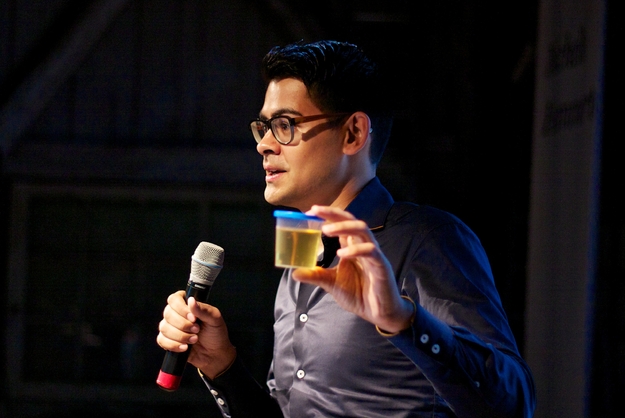Anne Vaandrager
Historically, leather tanneries have used different kinds of substances that influenced the tanning process. Using her kitchen to pursue her research intuitively, Designer Anne Vaandrager manipulated this traditional process using an experimental approach for the project Reality Tank by Droog. Among other things she used urine as a material to see what it does to leather. Ever since, she has been expanding her research in using urine as an artistic material.
Kamiel Rongen - Kamiel Rongen speaks on the third Pis'talk


Ruben Verwaal
Do you think we are the only ones obsessed with urine? Actually, pee has also been a hot topic and fundamental resource in the past within a large variety of fields, flowing from artisan craftsmanship to scientific investigation and vice versa. In each context the golden material was used for a different purpose and was given different meanings. Besides being a beauty lotion, a mordant essential to dyeing, and a cleanser for washing up clothes, this special bodily fluid played a relevant role in the development of science, especially medicine. Eager to know more? Ruben Verwaal from the University of Groningen is here to share his research about the concept of materiality, the historical background of pee and its fame among 18th century-chemists.
Ruben Verwaal - Verwaal spoke on the pis'talk 3

And for those who missed this presentation, you can still listen to Ruben Verwaal here.
Kamiel Rongen
What do you think of the combination of pee and music? We are not talking about the music which is used to cover up the unpleasant sound of someone urinating, but pee that integrates into a mesmerizing video installation that, in turn, will make your pee-break a unique experience. Kamiel Rongen, artist and musician, will explain how the magic happens at Pis'Talk. For those of you guys that want to be involved, come to Biotoop for the opening of Dijkspark to relieve your bladders on Mediamatic's façade for the pee of a lifetime!
Anne Vaandrager - Vaandrager presenting at the third Pis'talk



Michelle Hammerton
Urine-based fertilizers may represent an efficient alternative to traditional fertilizers, considering that pee is an abundant resource available at almost no cost. Yet, it is necessary to understand what the nutritional capacity of this kind of fertilizer is and to what extent do the fertilized plants take up micro-pollutants. In June, during the second Pis' Talk, Michelle from Metabolic presented her research. She dealt with chemical, as well as health issues regarding the optimization of nutrient recovery from urine by struvite crystallization and adsorption using chemical components such as zeolite and biochar. During the summer she continued experimenting and she is now ready to reveal the results of her study. Will the tomatoes she grew in the greenhouse at Mediamatic be the springboard to more sustainable agricultural practices?

Info
Pis’ Talk: Urine Matters and Materials
Thursday, September 24th
Drinks and food from 18:00, talk at 20:00
Biotoop Mediamatic, Dijksgracht 6, Amsterdam
Tickets: €8,50 (€3,50 for members) - food excluded
Students pay only €5! Fill in the discount code 'student' at the check-out. NB: we will ask you to show your student id at the ticket service.



